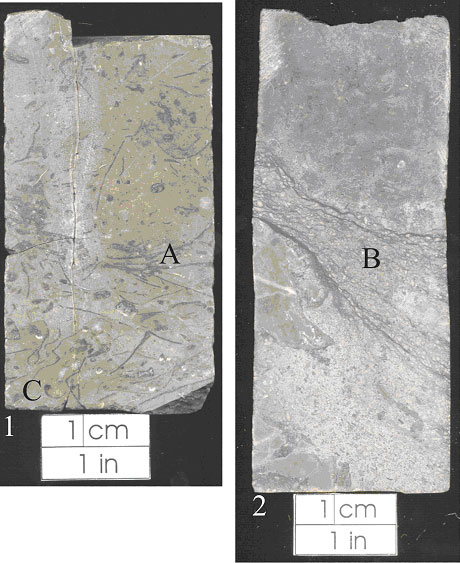 |
|
Kansas Geological Survey Open-file Report 2003-82 |
2.1.8 Bioclastic Mudstone to Wackestone Facies
Description
The bioclastic mudstone to wackestone facies is typically medium to dark gray
in appearance with a micritic matrix. Diagnostic features include medium bedding
(10-30 cm), abundant well-preserved whole-fossil marine bioclasts, and high-degree
of bioturbation (Figure 2.10). Stylolites are commonly observed in the upper
portion of the facies. Identified fossils include bryozoans, crinoids, brachiopods,
mollusks, foraminifera, phyloid algae, and chaetetids. Thickness of the bioclastic-mudstone-to-wackestone
facies ranges from 1 to 20 feet with an average of 12 feet (0.3 to 6 m; average
of 4 m). Upper and lower contacts of the bioclastic-mudstone-to-wackestone
facies with adjacent facies are gradational.
Paleoenvironmental Interpretation
Bryozoans, brachiopods, phyloid algae, formainfera, chaetetids and crinoids
indicate a normal salinity marine environment (Heckel, 1972). The presence
of a micrite matrix is evidence of a low energy environment. Presence of well-preserved
whole body fossils suggests a low-energy environment, probably below fair
weather wave base. Disarticulation of bioclasts is due to bioturbation or
storm activity. The combination of abundant and fragmented marine fauna, a
micritic matrix, and texture suggests that the bioclastic-mudstone-to-wackestone
facies was deposited in an open marine environment, probably below wave base.
Historically, the bioclastic mudstone to wackestone facies would be interpreted
as part of the “upper limestone” in the cyclothem model (Heckel,
1977).
 |
| Figure 2.10 - Polished core section of bioclastic mudstone to wackestone facies with abundant whole fossil bioclasts. Note well persevation of bryozoans (A), chaetetes (B) and brachiopods (C). Sample 1 from 650' and sample 2 from 645' in the Hinthorn CW#1 well, 14-T32S-R16E, Montgomery County, Kansas |
e-mail : webadmin@kgs.ku.edu
Last updated December 2003
http://www.kgs.ku.edu/PRS/publication/2003/ofr2003-82/chapter2_8.html